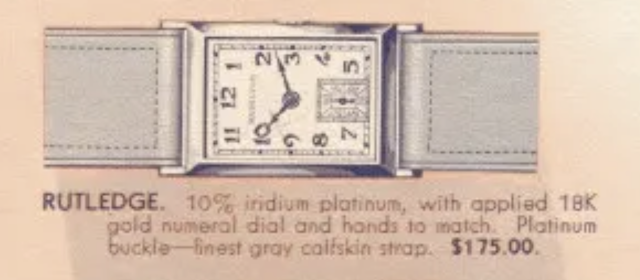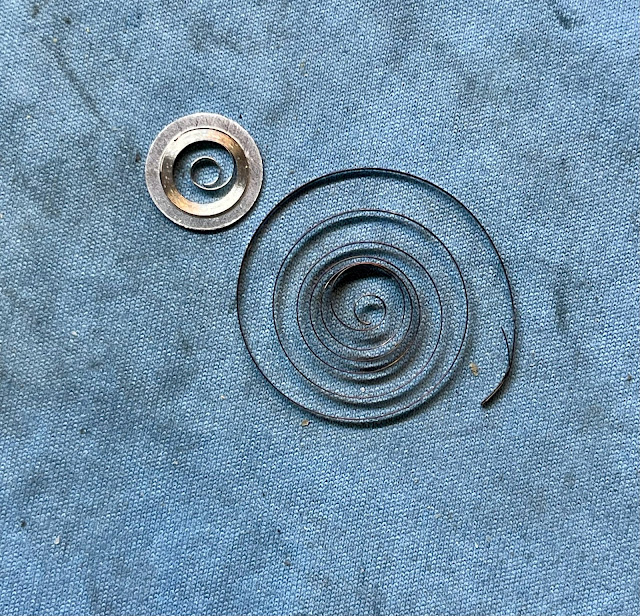Some of the hardest to come by models are those made in platinum. It's easy to find platinum watches for sale with Hamilton on the dial. In fact, on any given day you can see several for sale on eBay. What makes them hard to come by are a couple of factors. First, the price. Second, often they aren't even legit Hamilton models but simply Hamilton movements with blinged out dials in an aftermarket platinum case. That's especially true for ladies watches but for men's models as well. You have to be very careful with purchasing a men's model in platinum... buyer beware.
There are really only two men's models you'll come across in platinum, although there are a number of rarities out there as well... like a platinum Oval. However, the garden variety, to use the term, would be the 1935 Rutledge and the later 1951 Cambridge.
The Rutledge was a long-running model. It was introduced in 1935 and produced through 1951.
Priced originally at $175, that's the equivalent of over $3800 in today's dollars. It was, by far, Hamilton's most expensive model. That means my wife would surely have liked it.
The price stayed the same through 1940, although the buckle on the strap was solid gold instead of platinum like it was initially... cheap skates!
After the war you could purchase the Rutledge for a mere $300, over $4,000 in today's cash. Interestingly the Cambridge was mentioned in the 1948 catalog but didn't actually show up in the catalogs until 1951.
Finally, in 1951 the Rutledge arose to a price level of "if you have to ask, you can't afford it" and they would tell you how much it cost once you agreed to buy one. Notice the hands changed to alpha/pointex style from the spear style shown ealier.
I've posted on the Rutledge before but I recently received one in need of some help so I thought I'd show you one again.
As received, it looks pretty good. Platinum is pretty tough so the cases usually present well. The crown on this example is a little large and protrudes from the side of the case a little but only a purist would spot that.
Tucked inside the case is a 982M movement that dates to 1942. Notice anything peculiar? The 19 jewel 982M was introduced in 1940 and used in solid gold or platinum models. It's essentially the same as a 982 but finished to a higher degree of refinement and has a solid gold medallion inset in the train bridge. The 982 movement used in solid gold models previous was then dedicated to 14K gold filled models and the 17 jewel 980 was used for 10K gold filled and stainless models.
This movement has a replacement balance cock from either a 980 or a 982. Notice it's lacking damascening and the gold enamel. At some point the movement had a balance issue and the quick and dirty repair was to swap balances from another movement. There's actually a lot that can go into fitting a balance and it's possible the original balance cock was damaged. Only time could tell, it is what it is.
This watch was sent to me mainly because it didn't snap into the setting position and winding position like it used to. The set bridge below (left) is compared to another example on the right. They look the same but when I touched the set bridge on the left the arm broke off - so it had failed from fatigue after 80 years. It's an easy replacement.
The mainspring inside the barrel has "set" and lost most of it's potential energy. I'll replace it with a fresh white alloy Dynavar spring. It will run twice as long now.
Everything is disassembled, inspected and cleaned. Now I can reassemble it with fresh lubricants.
The reassembled movement is noticeably shinier and ticking away with good motion.
The timer says it's running a little fast but I should be able to slow it down.
The finished watch looks about the same as what I started with, just a little cleaner. But the crown still sticks out a smidgeon too far.
The owner gave me the green light to change the crown out with a slightly smaller crown that would fit in the recess of the case. It took quite a bit of fitting but eventually I got one to snug in just the way it was originally intended to look. It looks a lot better, don't you think?













No comments:
Post a Comment